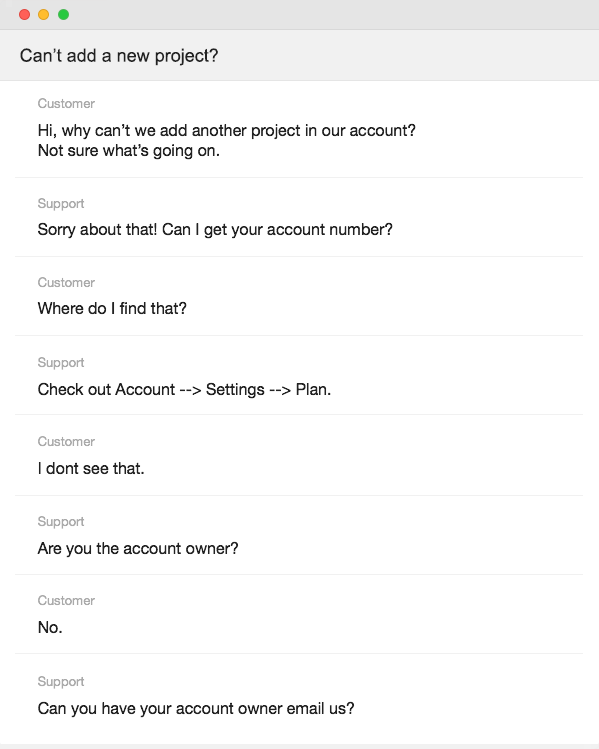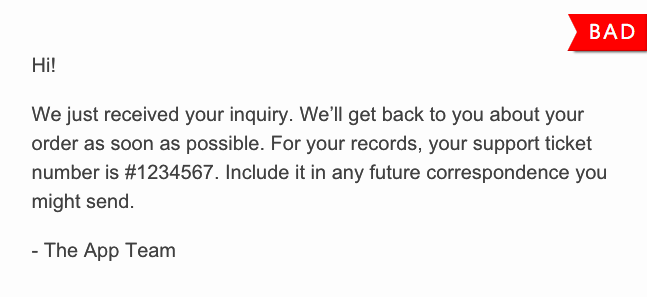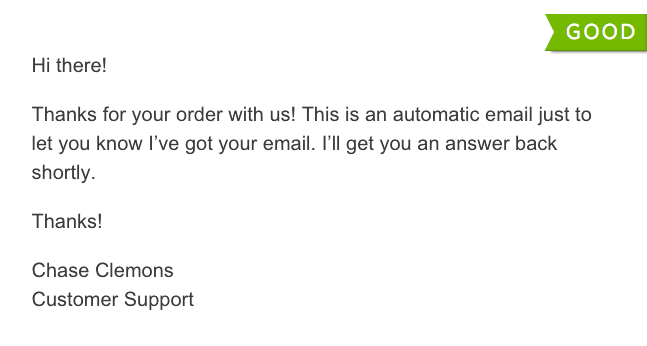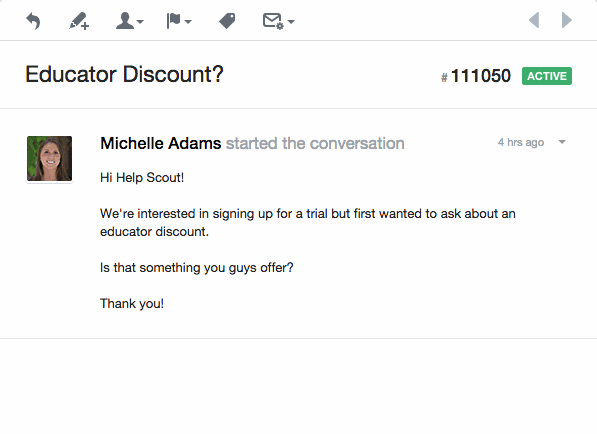There are a number of customer service tips that have been used time and time again to create great experiences.
After years of working at Help Scout and talking to industry-leading support managers, I’ve noticed 16 tips that all of the best support departments follow.
1. Make sure you're using the right tools
There is just no substitute for knowing your customers. The right support tools make it easy. You’d be surprised at the number of meaningful conversations you can have when you no longer have to stumble around in the dark.
It’s frustrating to be on the receiving end of support when the team isn’t outfitted correctly. I watched such a scenario unfold a while back with brand new software I was using:

You risk ruining your first impression when you treat your customers like Comcast treats people calling in: “Can we have your personal information, account information, blood sample, and deepest fear?”
With Help Scout, you can avoid this situation entirely through using features like built-in customer profiles.
There is a reason why tools like Google Collaborative Inbox fail for customer service. Sure, you can send emails to and receive emails from customers, but that's the extent of the tool's features. To deliver great support, your team is much better served using a platform that's built specifically for customer support.
2. Communicate clearly with customers
Excellence in anything increases your potential in everything. There are few positions for which this applies more than support — clarity in communication is paramount because it affects everything you do.
Styling affects communication. Tone affects communication. Common mistakes include using passive-aggressive language (“Actually…”) or confusing customers with slang, colloquialisms, or technical jargon.
Here’s another: which one of the following statements do you think is more appropriate?
You are being transferred. Your call is very important to us.
Hey Jane, I’m going to introduce you to our customer success specialist who will be better able to answer your question!
Easy. One is a trite platitude that people are sick of hearing. The other explains to customers why the transfer is to their benefit. Wording makes all the difference.
3. Speak as your customers do
Chase Clemons of Basecamp makes this point with gusto in "How to Write Support Emails Your Customers Will Love", but the quick takeaway is that your customers want conversations, not “correspondence.” You’re not talking with the Queen of England.
Consider the following disappointing example:

The customer is literally treated like a number. The overly formal tone creates the feeling that a letter is being written to a 16th century nobleman — is this an “inquiry” or a conversation with a real person?
Be friendly, personable, and casual. A follow-up email like this works better:

4. Always use positive language
Positive language is a great way to avoid accidental conflicts sprung from miscommunication. While the change is subtle, the effects are drastic.
Say one of your products is backordered for a month and you need to relay this information to a customer immediately. Consider the following responses:
Negative language: "I can't get you that product until next month. It is back-ordered and unavailable at this time."
Positive language: "That product will be available next month. I can place the order for you right now and make sure that it is sent to you as soon as it reaches our warehouse!"
Redirecting the conversation from negative to positive places focus on the proposed solution. When the outcome takes center stage, it reduces the odds that customers will be upset.
5. Give credence to customer complaints
Harsh words are not always indicative of insight, and complaining customers are not always a sign that something is wrong. Be that as it may, sometimes great feedback is buried within the vitriol — give credence to every message.
To stay consistent in tone and process, use the CARP method:
Control the situation.
Acknowledge the dilemma.
Refocus the conversation.
Problem-solve so the customer leaves happy.
Receiving the same complaint repeatedly is the beginning of a narrative. This shouldn’t dictate what to do next, but it will begin to reveal what requires your attention.
6. Avoid helping customers at breakneck speeds
"What builds a stronger tie to Arby's may not be whether a customer receives a sandwich in less than three minutes,” says Gallup researcher William J. McEwen. “Speed won't compensate for a cold, tasteless sandwich or for rude and incompetent service."
Make sure your service isn't leaving a bad taste in customers' mouths, either.
Take time to ensure first-contact resolution becomes a priority. There is nothing customers appreciate more than getting helpful advice the first time around.
7. Know how to close a conversation
The ability to close improves every single interaction. This is not closing a sale, it’s closing the conversation with a customer.
Leaving an issue unresolved creates unnecessary problems. Data suggests as little as 4% of dissatisfied customers will ever speak up. Not everyone will communicate what is bothering them—often because you haven’t communicated that you care.
Your willingness to correctly close a conversation shows the customer three important things:
You care about getting it right.
You're willing to keep going until you get it right.
The customer is the one who determines what “right” is.
“Is there anything else I can do for you today? I’m happy to help!” Always look for small opportunities like this.
Make sure you and your team always get to a place where, “Yes, I’m all set!” rings loud and clear.
8. Keep standards high and response times low
Inbox zero needn’t be a zero-sum game. Delighting users is impossible when the team’s morale is being crushed under the weight of a cluttered inbox.
Keep it simple, sunshine. Since basic, common questions are where your keystrokes go to waste, start by addressing them with scalable templates.
Saved replies are valuable to a support department because the whole team builds on them. Set guidelines for identifying common questions and when a saved reply can and should be created.
The more you add, the more useful your saved reply collection becomes.

9. Help customers help themselves
Great customer service should always be available, even when you aren’t.
When done right, self-service is personal at scale. View your help content as a top-tier reply from your customer support team made public for all to see and benefit from. Screenshots, videos, styling and more ensure your frequently asked questions will get frequently loved answers.
While impressive efforts like VHX’s documentation will take you some time, the journey of a thousand miles begins with a single step, and the journey to a useful knowledge base starts with your first article.
Help Scout Docs makes it easy. A few clicks auto-magically creates a logically organized help portal made to look as beautiful and usable as your own product.
10. Make use of strategic automation
“Filtering” can sound worrisome in the realm of customer service, but it more accurately serves as direction. Customers receive the best support possible when they are sent to the right place the first time around.
With Workflows, you can trigger automatic filtering through subject line keywords. This offers a number of advantages:
Make iterative improvements. Want to keep response times down to 6 hours? Set up a Workflow to remind the appropriate user(s) so that messages don’t sit and collect dust.
Highlight opportunities to ‘Wow!’ By setting up a folder and a Workflow for a keyword like “Refund” in the subject line, you’ll add a streamlined way to salvage potentially lost customers. Special conversations (“Upgrading,” “Canceling my account”) let you provide superb support at key crossroads.
Better manage VIP customers. It’s helpful to filter enterprise or long-term customers to their own folders to ensure timely responses. They may have different needs; set them up for success by getting them out of the main inbox.

Meaningful automation helps create more meaningful conversations. Best to use it wisely.
11. Be data-informed, not data-delusional
Why rely on “It feels like we spend a lot of time on this issue…” when reporting can easily eliminate the guesswork?
This is actually an important, often-overlooked issue in support. Too much focus is given to the frequency of issues over the average handle time for each.
Rather, that is your world before support metrics. Your world after is clicking the “Time Tracking” tag and gaining immediate access to data that tells you how many emails you receive about the feature, as well as how long it takes your team to handle the conversations.

Although great data cannot guarantee good decision-making, it’s better than winging it. The right data will help you keep your team in the loop. “Here’s how we did this week” becomes easy and valuable.
Satisfaction Ratings top it off by allowing you to see where support interactions went really well (or very wrong). Both are learning opportunities.
Better learning results in meaningful improvements. Being able to see through the haze of a thousand of emails is illuminating, and an important step in getting there is not relying solely on your gut.
12. Give thanks in the real world
We’ve entered a world where retention matters in business more than ever, but web businesses seem happy to avoid interacting with customers.
They aren’t pageviews — they’re people. How would you feel if a deli owner asked you to join their message board just to talk about how the cold cuts tasted?
Time to bring the personal touch back to the real world.
Consider this handwritten note that Jawbone sent to a new customer:

A single picture that was retweeted 150+ times—that’s an immense amount of goodwill “paid for” with a simple thank you.
What other 5-minute task creates as much ROI as that? You won’t have time to hand-write every customer, but if there is one activity that should never get lost in the shuffle of building a business, it’s thanking your customers.
13. Spot and deliver 'frugal wows'
Memorable experiences spring from the unexpected. When your team feels stifled by red tape, remember these words from Paul Graham: “An obstacle upstream propagates downstream.” If you make ideas hard to implement, your team will stop offering them.
Frugal wows are the answer, says Bain consultant Fred Reich. Take the opportunity to guide the support team away from throwing money at the problem, and instead pour thought and effort into it.
According to Rob Markey, disappointment strikes when companies try to “empower” their team the wrong way:
We know of one retail bank that gave their call center representatives the edict to delight customers and permission to waive up to $150 in fees for any customer without seeking any additional authorization. The result? Customer satisfaction rose a little, but fee revenue declined. A lot.
When a customer is looking for nothing other than free stuff, they aren’t a good fit for your business in the first place.
14. Unify your customer service team
Pro tip: managing customer service without a playbook can feel as chaotic as a pee-wee football game.
Consider the time lost manually answering frequently asked questions. The same principle applies to explanations to your staff on the back-end. Encourage autonomy and eliminate confusion by creating unity through clarity.
How?
Use a support lexicon. “Is it okay to say this?” Support should always feel welcome to ask, but you can eliminate excessive questioning through a support lexicon, a handbook on how to talk to customers. Focus on the dos and don’ts of tone and language, and outline the style of customer service you admire.
Address common objections. A while back I had a prospective customer make a “scale objection” to Help Scout. Could we handle 50 users? I knew some of our customers had over 400 unique users and replied as such, but I felt my answer would have been better with additional information. The next week, our support team made a customer objections doc, addressing things like competitor objections (“How are you different from ____?”) and pricing objections.
Outline your processes. When is it appropriate to write a piece of help content? Is it okay to set up a new Workflow without asking management? How should we document bugs and errors? Every support department will have these questions, and to best address them, give guidelines that allow for autonomy but that don’t leave people lost without a map.
15. Take a whole-company approach
I’ll let our friend Mathias Meyer handle this one, from a previously published essay on our blog:
“When everyone in the company is involved in customer service, it changes the dynamic significantly. Knowledge of issues, bugs, and features is much more widespread throughout the team.
Why is that beneficial?
Because everyone should be feeling the customer’s pain. With developers in particular, there's a common question that arises when the entire company is encouraged to be involved in customer service.
Shouldn't developers be writing code, shipping new features, and fixing bugs? After all, they're an expensive resource, and their time is much better spent improving the product rather than talking to customers, right?
But how will developers know best what kinds of problems their code solves and creates? The same is true for missing features. While product roadmaps handed down by management are useful tools, asking customers directly what kinds of problems they're having is incredibly powerful in determining new features.”
So simple that it shouldn’t be forgotten, yet it often is: talk to your customers. Get your whole team involved in customer service.
16. Invest in great people
The quality of your customer service will never exceed the quality of the people providing it.
If you plan on out-supporting the competition, plan on investing heavily in a team that can deliver.
Leadership has one main objective from which they should never stray: Hire who you trust and trust who you hire.
Customer service can either be nothing more than a means to an end, or it can be a dynamic aspect of your entire business. Engaging customers and helping them get the most out of your product will give them a reason to tell others why they love your company.
Use these tips, and I guarantee you’ll be on your way to world-class customer service.
Customer service tips by business type and industry







